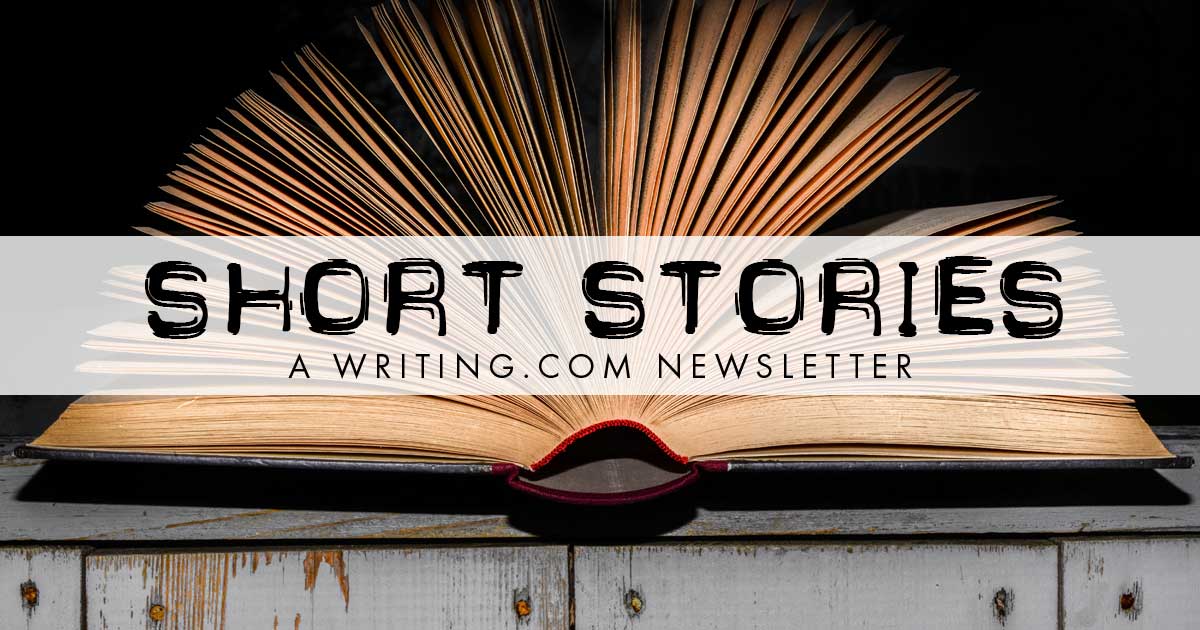This week: A Simple Tale Edited by: Annette  
More Newsletters By This Editor 
![Table of Contents [#401437]
Table of Contents](https://www.Writing.Com/main/trans.gif) ![Table of Contents [#401437]
Table of Contents Table of Contents](/main/images/action/display/ver/1709303267/item_id/401437.png)
1. About this Newsletter
2. A Word from our Sponsor
3. Letter from the Editor
4. Editor's Picks
5. A Word from Writing.Com
6. Ask & Answer
7. Removal instructions
![About This Newsletter [#401439]
About This Newsletter](https://www.Writing.Com/main/trans.gif) ![About This Newsletter [#401439]
About This Newsletter About This Newsletter](https://www.writing.com/main/images/action/display/ver/1709303676/item_id/401439.png)
| "The short story is usually concerned with a single effect conveyed in only one or a few significant episodes or scenes." Britannica |
![Letter from the editor [#401442]
Letter from the editor](https://www.Writing.Com/main/trans.gif) ![Letter from the editor [#401442]
Letter from the editor Letter from the editor](https://www.writing.com/main/images/action/display/ver/1709303784/item_id/401442.png)
A Simple Tale
The modern definition of the short story came to be in the 1800s. The truth is that short fiction has been around since the beginning of language. Tales told around the night fire have been the vehicle for one generation to teach the next generation. Even before the invention of concepts like pedagogy, humans understood that narratives that exaggerate facts are more likely to stick with the listeners. Some of the most wondrous natural events had been solved for many generations before science came and messed it up.
Ancient short story types include:
Folk tales about the origin of animals or humans abound across all cultures.
Fables involving talking animals are short and have one simple message.
Fairy tales reflect the morals of the time they are told in through some type of dramatic encounter.
Legends distill the lore of a whole tribe into a few heroic deeds by a small number of people.
Myths that explain the gods and what they do.
Anecdotes that work similar to moralizing fairy tales, but instead of hiding the story in a wondrous cloak, it's conveyed as an insight into the way an issue has affected someone's life.
Some of these can present as if they are retelling some event that was real, but they all include an element of make-believe and exaggeration. One thing these narratives have in common is that they provide a story with a satisfying ending. Satisfying does not mean a happy ending or one that satisfied the reader's personal hopes for the characters. A satisfying ending means one that makes the story complete.
Do you prefer stories that are realistic or all fiction?
|
![Editor's Picks [#401445]
Editor's Picks](https://www.Writing.Com/main/trans.gif) ![Editor's Picks [#401445]
Editor's Picks Editor's Picks](https://www.writing.com/main/images/action/display/ver/1709303830/item_id/401445.png)
| |  | Invalid Item 
This item number is not valid.
#2305251 by Not Available. |
|
![Word From Writing.Com [#401447]
Word from Writing.Com](https://www.Writing.Com/main/trans.gif) ![Word From Writing.Com [#401447]
Word from Writing.Com Word from Writing.Com](https://www.writing.com/main/images/action/display/ver/1709303874/item_id/401447.png)
Have an opinion on what you've read here today? Then send the Editor feedback! Find an item that you think would be perfect for showcasing here? Submit it for consideration in the newsletter!
https://www.Writing.Com/go/nl_form
![Ask & Answer [#401448]
Ask & Answer](https://www.Writing.Com/main/trans.gif) ![Ask & Answer [#401448]
Ask & Answer Ask & Answer](https://www.writing.com/main/images/action/display/ver/1709303902/item_id/401448.png)
Replies to my last Short Stories newsletter "Get to the Point"  that asked: How soon do you think is too late to rope the reader in? that asked: How soon do you think is too late to rope the reader in?
stevengepp wrote: Having had over 90 short stories accepted by various publishers, what I have come to think is it depends on the length of the short story as to how much time you have to hook the reader. Normally, it seems to be 3 paragraphs or so. However, once the story goes over about 5k words, you have a little more time; once it is less than 1000 words, first paragraph, preferably first line. Well, that's what works for me.
All of this is good advice. Thank you for sharing from your experience.
Damon Nomad  wrote: Thanks Annette wrote: Thanks Annette   for including one of my stories in your newsletter. Your theme and points about "Getting to the Point" are spot on for short story fiction. I recently had a piece running near a submission limit of 5000 words. I put it aside for a couple of days and read it again. There were too many words I liked, but the reader did not need. Ended up around 3500. It was also a bit flat and needed a faster pace. Revise, Revise, Revise then revise again. for including one of my stories in your newsletter. Your theme and points about "Getting to the Point" are spot on for short story fiction. I recently had a piece running near a submission limit of 5000 words. I put it aside for a couple of days and read it again. There were too many words I liked, but the reader did not need. Ended up around 3500. It was also a bit flat and needed a faster pace. Revise, Revise, Revise then revise again.
It's so true how the first version, no matter how much we love it in the moment, usually needs a lot more work to make it really all that we wanted it to be. Thank you for your insights.
Beholden  wrote: Thank you very much for including my short piece, Calendar, in your Editor's Picks section. wrote: Thank you very much for including my short piece, Calendar, in your Editor's Picks section.
I'm the one who's thankful for prolific writers like you who give a lot of examples to showcase. |
![Unsubscribe [#401452]
Removal Instructions](https://www.Writing.Com/main/trans.gif) ![Unsubscribe [#401452]
Removal Instructions Removal Instructions](https://www.writing.com/main/images/action/display/ver/1709303960/item_id/401452.png)
To stop receiving this newsletter, click here for your newsletter subscription list. Simply uncheck the box next to any newsletter(s) you wish to cancel and then click to "Submit Changes". You can edit your subscriptions at any time.
|
